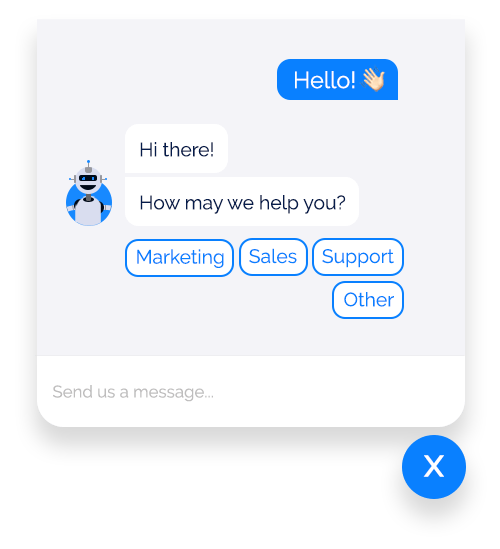There are lots of metrics floating around the customer service industry—it’s hard to keep them straight! But the two we hear most often are CSAT scores and NPS®.
You know they’re both important, but what’s the difference?
They’re both short, often one-question surveys that use numerical scales. The big difference? CSAT scores (customer satisfaction) measure one specific interaction, while NPS (Net Promoter Score®) evaluates the overall opinion of your business.
Hint: You need both in your business.
Keep reading to learn how to use CSAT and NPS surveys, and what you can do to raise your scores.
What is a CSAT score?
A customer satisfaction (CSAT) survey asks customers a single question: On a scale from one to five, how satisfied were you with [company/service/product/interaction]?
To get the CSAT score, you take the average number of respondents who answered either fours (satisfied) or fives (very satisfied).
The CSAT formula
Total number if 4 and 5 responses ÷ Total number of responses x 100 = % of
satisfied customers
Simple, right? That’s the beauty of CSAT surveys. They’re easy to answer because it’s multiple-choice and comes immediately after the interaction. Customer responses tend to be higher than other forms of surveys.
What makes CSAT scores such powerful metrics is their ability to be used across the organization in a variety of ways. The best way to use it in customer service? Immediately after a customer interaction.
It can also evaluate products and services, the e-commerce experience, a piece of content, and more.
How do you use CSAT scores in your business?
Customer satisfaction scores are a quick and easy way to get immediate customer feedback. And with Zendesk reporting that over 60% of customers admitting that the pandemic has raised their customer service expectations, staying on top of customer satisfaction is critical to business success.
CSAT is a numbers game. The more customers you get to answer the survey, the better picture you’ll have of your customer service as a whole. While responses tend to be higher than those of other surveys, customers already show signs of survey fatigue.
Here are a few ways to increase response rates.
Best practices to increase CSAT score response rates
- Include the survey in their preferred messaging channel. Don’t rely on an email after the interaction (which comes with a meager open rate and an even lower response rate). Instead, send customers the survey right within the messaging platform they’re already using. If the conversation happened over text messaging, send the survey via text at the end.
- Use a chatbot to administer the survey. Automate survey distribution and capture sentiment while it’s still fresh in your customers’ minds. Program your chatbot to jump into the conversation once the customer’s problem is solved. Better yet? Have your agent introduce the bot for a streamlined handoff. Then your customer knows it’s coming before they sign off.
- Make the survey visually engaging. Use rich messaging to make your surveys stand out. Try emojis when appropriate, test out stars vs. a number scale, or even try incorporating gifs. See what it’ll take to get your customers to click!
- Be specific. Make sure you say exactly what you’re asking for. A vague “rate us” won’t elicit a good response, but something like “How did Jenny do on this request?” might.
If you’re thinking, “This is great! But what does it really tell me about our customer service team?”, then it’s time for some deeper questions.
 You have a few options. Consider adding an optional question that asks why your customers scored the way they did. This captures in-the-moment information to help you discern the problem or what made that customer service experience stand out.
You have a few options. Consider adding an optional question that asks why your customers scored the way they did. This captures in-the-moment information to help you discern the problem or what made that customer service experience stand out.
But adding additional questions (even optional ones) could keep customers from answering the survey altogether. Maybe they feel like they need to think through their answers a bit more or feel like it’s just too much.
If that’s the case, you can also let them opt-in to receive a follow-up survey that goes into more details. If they agree, send them an email with questions that dig into the heart of the problem. For severe issues or standout surveys, you can even request an interview (and offer an incentive to participate).
It’s also important to note that you’re more likely to hear from customers on either end of the spectrum. The people who had very positive experiences (fives) and extremely dissatisfying experiences (ones) are the most likely to respond to your surveys. Keep that in mind when assessing your customer service experience.
What can you do to improve your CSAT score?
That depends on what you’re measuring.
Let’s assume you’re measuring your customer service interactions. Every customer wants a few key things when they reach out to your support team.
- Quick resolutions: 61% of customers define a good customer service experience as one that solves their problems quickly. Make sure your staff is well-trained and has access to all the information they need to serve your customers.
- Timely responses: Customers expect access to support agents 24/7. While this isn’t always possible, there are several options to serve customers when agents aren’t available. Many customers want self-service options, so spend the time and effort to enhance your knowledge base. You can also rely on chatbots to answer common questions and set expectations for when an agent will be available. Relying on asynchronous messaging, like text messaging, will also help with more flexible response times.
- A friendly customer service agent: Now more than ever, customers are looking for empathy from your customer service agents. Train your agents to practice patience and kindness (and ensure they can translate those emotions into text), and empower them to flex the rules and do what it takes to make the customer happy.
What is NPS?
NPS stands for Net Promoter Score, and it calculates how likely your customers are to recommend your brand.
An NPS survey asks the question, “How likely is it that you would recommend [brand] to a friend or colleague?” Customers then rate their likelihood from 0–10, with zero being not at all likely and ten being extremely likely.

When calculating your NPS, only customers who select nine or ten are considered your promoters, while passives score seven and eight, and detractors score zero through six. So calculating your NPS looks a little different than calculating your CSAT score.
The NPS formula
% of promoters — % of detractors = NPS
Pros and Cons of Net Promoter Scores (NPS)
Your NPS identifies overall brand perception rather than a specific transaction. This leads to several pros and cons.
[fusion_table fusion_table_type=”2″ fusion_table_rows=”” fusion_table_columns=”” hide_on_mobile=”small-visibility,medium-visibility,large-visibility” class=”” id=”” animation_type=”” animation_direction=”left” animation_speed=”0.3″ animation_offset=””]
| Pros | Cons |
|---|---|
| There’s a strong correlation between NPS (which measures loyalty) and business growth. | Since NPS measures perception instead of performance, it’s harder to pinpoint specific problem areas. |
| NPS is standardized across brands, so it’s better at providing benchmark numbers on which to base your business’ performance. | It requires a deep analysis of both industry-wide and internal trends to decipher the results. |
[/fusion_table]
Like CSAT surveys, NPS surveys often need a little help to get usable feedback from your customers. Ask respondents to explain their reasoning in a follow-up question. While asking another question may limit your responses, it’s better to have insights on what matters most to your customers.
So how often should you measure NPS? Since it’s an assessment of your overall experience, you’ll need to evaluate the best frequency and delivery method for your brand. Opt for at least once a year.
If your customer base is large and you change tactics frequently, you might want to consider sending out surveys once a quarter to get more immediate feedback.
What is considered a good NPS?
Since NPS scores are standardized, it’s easy to identify a benchmark score.
According to Sametrix, the average NPS for online shopping brands in 2021 was 41, and the industry leader’s NPS was 59.
Once you start tracking your own data, pay attention to internal and external trends that influence your score. For example, many brands may be experiencing lower than average scores due to supply shortages or long wait times.
How do you increase your NPS?
Once you’ve established your NPS baseline, you have a benchmark for future results. But since you aren’t measuring a specific interaction, it’ll take a little more digging to identify ways to improve it. Here are some ways to get started:
- Dive into the data: Instead of looking at your NPS as a standalone metric, compare it to what you know about your customers. Are your promoters Gen Z and your detractors Gen X? Did all your promoters buy a particular service? Look at what other metrics you can pull in so you have a bigger picture of the results.
- Look at the internal context: What was going on when you sent out that survey? Had you just released a new product? Was your customer service team understaffed? See what could have influenced your responses. It may not give you the whole picture, but it can help you identify where to start.
- Review industry-wide trends: It’s no secret that the pandemic caused net promoter scores to drop due to a variety of factors. But it doesn’t have to be a global problem to impact your customer service. See what external trends may have contributed to the score.
To increase your NPS, you need to do some investigating and then rally your customer service team around the solutions. With the right tools and understanding, it’s absolutely possible to increase your scores.
Should you use NPS or CSAT to evaluate your customer service?
Ideally, you should use both NPS and CSAT scores to get a full understanding of how your brand is performing. While NPS is great at measuring the overall sentiment around your customer service, product, etc., CSAT surveys will provide specific, actionable insights into support interactions.
Unlock your customer metrics with Quiq
Not just another conversational platform. Quiq uses powerful AI to connect your customer service team with your customers.
- Meet customers where they are with multi-channel support
- Use chatbots to automatically deploy CSAT and other surveys
- Serve more customers with asynchronous messaging and efficiency tools
Interested in seeing what Quiq is all about? Watch our video here.


